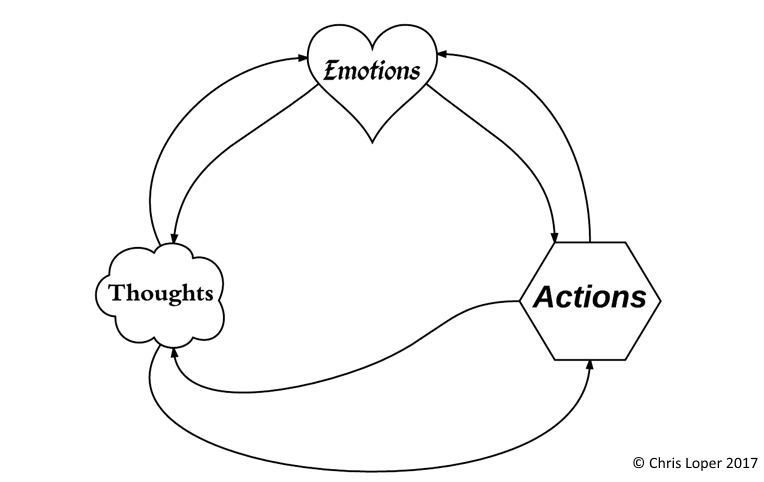
For the past decade, my injuries have kept me in some kind of physical pain for most of my waking hours. But am I always suffering?
No.
In fact, I’m generally happier than I was before I got injured. Let’s unravel this apparent paradox.
Pain Does Not Equal Suffering
It’s a common misconception – one that I held for most of my life – that pain is synonymous with suffering. But really, they’re not the same at all. Physical pain is just nerve signals being registered by the brain. That’s all it is. How you interpret those signals is a matter of choice. Suffering, on the other hand, is emotional, and it’s caused by the standard way we respond to pain signals.
The standard response to pain is resistance. Pain is, of course, unpleasant, so we’re biologically programmed to dislike it and avoid it. That’s a basic feature of our evolved psychology. And this response is often helpful.
Pain evolved to be a signal that gets our attention. It says things like, “Hey! Take your hand out of that fire, dummy!” and “You just sprained your ankle. Sit down.”
And beyond these immediately practical responses, the emotional suffering caused by pain can be a powerful teacher. It can prevent us from making similar mistakes in the future.
But pain is frequently an unhelpful signal. My injuries are all old. The pain is chronic, and it rarely communicates anything useful about how I should behave. It’s mostly just … there. And since I can’t act on it, and since I can’t make it go away, the only logical thing to do is accept it. And when you accept pain, it doesn’t cause you much suffering.
Resistance Causes Suffering
The suffering that we associate with pain isn’t really caused by the pain itself; it’s caused by our resistance to the pain. Trying to numb it or pretend it’s not there, wishing in vain for the pain go away, and feeling sorry for ourselves are all examples of resisting pain. And although these are understandable responses, they cause us to suffer.
Consider, as an example, the pain of getting a shot at the doctor’s office. Adults, who understand the importance of getting a shot and who have practiced tolerating this sort of pain, do not suffer greatly from getting a shot. But children, who have no concept of the value of vaccines and who have little practice tolerating this sort of necessary pain, suffer greatly.
Or think about the difference between pain you choose and pain you don’t choose. If you go climb a mountain, you’re going to experience pain and discomfort, but you’ll probably suffer little. Why? Because you’re not resisting the pain – you’re choosing it. Meanwhile, something that is objectively less painful, such as a canker sore, can cause you far more suffering because you did not choose it. As such, you’re likely to resist it.
The same is also true for pain that isn’t physical: the pain of a loss, the pain of not getting what you want, people being a pain in the ass, etc. When you encounter these things, you’ll feel upset, disappointed, frustrated, or annoyed. These automatic reactions are psychological pain. And they cause suffering when you resist the realities that caused them – when you do not accept a loss, when you feel entitled to things you do not have, when you try to force other people to change, etc.
My Shift Toward Acceptance
Accepting pain is much easier said than done. It requires overcoming the default system, which would have me resist the experience of pain. And I spent the first five years of living with chronic pain doing just that.
I hated it. I wished it would go away. I used mindless distractions in an effort to ignore it. I took drugs to numb it. And I suffered greatly. Most of the time, I felt like a helpless victim.
Gradually, I learned to change my psychological response to pain. I quit taking drugs to numb my pain. I started favoring mindfulness over mindless distractions. I started interpreting reality in more helpful ways. And I stopped longing for that distant day when my injuries would all be gone – a day that I don’t believe will ever come. I came to accept that pain will be a part of my daily life, and I decided that this fact should not get in the way of my happiness.
So when I’m in pain, do I just sit there and take it?
No!
Often there’s something I can do about it. I have physical therapy remedies for my back, neck, and hip pain. I can alleviate the inflammation in my foot with anti-inflammatory cream or cold water or reflexology treatments. I always start by doing what I can to actually address the problem. And sometimes, when I’ve been hurting worse than usual for many hours, I’ll take Tylenol. Acceptance doesn’t mean submission.
But what makes my psychological approach so different now is that I don’t get upset about being in pain to begin with, and if my remedies fail, I know I’ll still be okay. I don’t get mad and feel sorry for myself. I acknowledge the pain and get on with my life. I don’t like pain, but I also don’t resist it. As a result, I suffer much less.
Well, at least that’s my intention. I don’t always live up to that ideal. Sometimes the default option gets the better of me. Acceptance isn’t an all-or-nothing thing; it’s a skill that you have to practice.
The big idea here is that we all routinely turn pain into suffering by resisting it rather than accepting it. And how much suffering? Well, that depends on the level of resistance.
Suffering = Pain x Resistance
“I once went on a meditation retreat with a wonderful teacher named Shinzen Young, who gave me words of wisdom that I’ll never forget. He said that the key to happiness was understanding that suffering is caused by resisting pain. We can’t avoid pain in life, he said, but we don’t necessarily have to suffer because of that pain… he chose to express these words of wisdom with an equation: ‘Suffering = Pain x Resistance.’ … His point was that we can distinguish between the normal pain of life—difficult emotions, physical discomfort, and so on—and actual suffering, which is the mental anguish caused by fighting against the fact that life is sometimes painful.” –Kristen Neff, Ph.D.1
In other words, the greater the resistance, the greater the suffering. We may not be able to control how much pain we experience in our lives, but we can reduce our suffering by accepting rather than resisting that pain.
We could even think of suffering itself as a form of pain – one that we make worse by resisting.
“Carl Jung said that so much unnecessary suffering comes into the world because people will not accept the ‘legitimate suffering’ that comes from being human.” –Richard Rohr2
This has actually been studied.
Critically, this isn’t just an idea that seems true. It is supported by research:
“A number of studies have compared the effects of two contrasting anticipatory attitudes—acceptance and suppression— on pain perception. Some people have a natural tendency to look ahead to the repetition of a familiar pain stimulus with acceptance. They tell themselves, ‘This is going to hurt, but no worse than before.’ Other people try to cope with the same situation through suppression, a form of denial. They tell themselves, in effect, ‘I really hope this doesn’t hurt as much as it did the last time.’ Psychologists have generally found that, compared to suppression, acceptance reduces the unpleasantness of pain without reducing the pain itself.”3
So acceptance can actually reduce the suffering caused by painful experiences. But acceptance can be a tricky concept, so let’s talk about it.
Acceptance
Accepting that you’re in pain isn’t the same thing as enjoying the pain. It doesn’t mean you’re grateful for the pain. It doesn’t mean you seek out pain. And it doesn’t mean that, when pain occurs, you just passively take it.
Acceptance just means acknowledging what you’re dealing with and facing it head-on. You don’t try to run away from the pain, hide from it, or pretend it’s not there. Instead, you try to deal with it in the healthiest way possible. Acceptance might seem passive, but it’s actually the proactive choice.
- Usually, that means trying to actually fix whatever is causing you pain.
- Failing that, you try to put up with the pain without getting upset about it or feeling sorry for yourself.
- If the pain is so bad that neither of those options work, numbing it and/or distracting yourself from it are options of last resort, which should only be employed rarely and should never be used as long-term “solutions.”
Acceptance isn’t necessarily easy, and it rarely happens instantly. It’s the last of the five stages of grief, after all. But it is something we can choose. And it is something we can work toward.
The opposite of acceptance is psychological resistance – saying to yourself, No, this shouldn’t be! Such resistance only creates frustration and anguish. As Kristen Neff writes in Self-Compassion, “Our emotional suffering is caused by our desire for things to be other than they are.”1
Neff also explains why acceptance is the only logical response to whatever you’re experiencing:
“Once something has occurred in reality, there is nothing you can do to change that reality in the present moment. This is how things are. You can choose to accept this fact or not, but reality will remain the same either way.”1
Or there’s this gem from Byron Katie:
“When I argue with reality, I lose—but only 100% of the time.”4
If this sounds familiar, perhaps it’s reminding you of mindfulness. Acceptance is one of the four components of mindfulness. And that brings us to the origin of this whole idea: Buddhism.
Suffering from a Buddhist Perspective
Recall that Neff learned this principle while on a meditation retreat. I just finished a deep dive into Buddhist philosophy (via Robert Wright’s excellent book, Why Buddhism is True), so this doesn’t surprise me.
Buddhism is sometimes oversimplified and misconstrued as claiming that “all life is suffering.” The actual philosophy is quite a bit more interesting – and optimistic – than that. Please pardon the jargon.
The Buddha taught that “the cause of dukkha – of suffering, of unsatisfactoriness – … is tanha, a word usually translated as ‘thirst’ or ‘craving’ and sometimes as ‘desire.’ To put a finer point on it, the problem is the unquenchability of tanha, the fact that attaining our desires always leaves us unsatisfied, thirsting for more of the same or thirsting for something new.”5 Our desires can never be satisfied in any lasting way, so desire causes suffering, or at least it causes a recurring sense of dissatisfaction.
Tanha includes “not just the desire for things you find pleasant – sex, chocolate, a new car, a newer car; it also includes the desire to be free of things you find unpleasant. In other words, tanha fuels not just attraction to alluring things but also aversion to off-putting things.”5 In other words, resistance is a form of desire. Hence, resistance causes suffering because desire causes suffering.
Life will always force things on us that we don’t want, such as pain. And when we choose to resist those things, we suffer. Adults do this all the time, but it’s easier to see in children, whose resistance is often more dramatic. Think of a toddler being told that playtime is over and he has to go take a nap. The ensuing tantrum is a perfect example of someone suffering because they’re resisting reality.

Now here’ the optimistic part:
“the two sides of tanha, a clinging attraction to things and an aversion to things – needn’t enslave us as they tend to do. Meditative disciplines such as mindfulness meditation can weaken the grip they exert. … It’s important to emphasize that becoming less enslaved by craving and aversion doesn’t mean becoming numb to feelings; it can mean developing a different relationship to them and becoming more selective about which feelings to most fully engage with. Indeed the revised relationship can include the accentuation of certain feelings, including wonder, compassion, and the sense of beauty.”5
And you don’t necessarily have to meditate in order to reduce desire’s grip on you – it just usually helps. In principle, you can practice accepting whatever your current situation is on a moment-to-moment basis as you go about your daily life. This will make you feel more satisfied with the good things you already have and less unhappy about the things you’d rather not have, such as pain.
This can improve your experience with unpleasant emotions. In Sapiens, Yuval Noah Harari explains that “If you experience sadness without craving that the sadness go away, you continue to feel sadness but you do not suffer from it.”6
How Does Meditation Help?

In meditation, you practice sitting with whatever arises in your mind. You might feel hungry, but instead of going to get a snack, you continue to sit there, experiencing your hunger without acting on it. You might think of a chore you need to do, but instead of getting up and doing it, you continue to sit there, experiencing the thought without acting on it. This practice helps you be less controlled by your mental states.
And it also creates an opportunity to observe how your mind works:
“You watch pleasurable experiences arise and fall, and you see that they never last; you watch pain come uninvited and you watch yourself anxiously struggling to throw it off; you see yourself fail. … You see that your life is marked by disappointment and frustration, and you clearly see the source. These reactions arise out of your own inability to get what you want, your fear of losing what you have already gained, and your habit of never being satisfied with what you have… You see the way suffering inevitably follows in the wake of clinging.” –Bhante Gunaratana7
The thoughts and feelings and physical states you experience while meditating might be painful, but, by simply sitting with them and observing them come and go (or come and stay), you reduce the power they have over you. You prove to yourself, little by little, that you can accept mental and physical states you don’t like.
Taking action helps too.
An alternative way to practice acceptance is taking positive action in response to – or in spite of – pain. Allowing pain to shut you down makes you a passive victim of pain. This might seem like acceptance, but it’s not. Accepting pain means acknowledging that you’re hurting, and then moving forward anyway.
Here’s how Dan Millman puts it in Everyday Enlightenment:
“Emotions, no matter how painful they are, are not the problem. The problem is dropping out of school or work, putting your family or duties of life on hold until such time as you can work out your emotional issues. Would you rather feel depressed while sitting alone in your room trying to figure it all out or feel depressed while getting your house cleaned or your project completed? (You may still feel depressed, but you have a cleaner house.)
The heart of accepting your emotions … is to do what you need to do despite what you are feeling. Accept and learn from your feelings, but don’t let them run your life. By remaining productive during difficult emotional episodes, you are more likely to improve your emotional state than if you do nothing but ruminate and wait for sunny skies.”8
Now, I’m not advising you to keep jogging after you sprain your ankle; that would just be stupid. And I’m not saying it’s never appropriate to sit and cry. But when you choose to take positive action in spite of the pain you’re in, it sends a powerful signal to your brain that you’re okay with the pain, that you’re accepting it.
Remember that actions are the most powerful way to take control of the feedback loop of thoughts, emotions, and actions that’s constantly running in your brain.

This action-oriented approach to pain and acceptance takes us out of the realm of Buddhism and into the arena of the Stoics.
The Stoic Perspective on Acceptance
The Stoics believed that setbacks, obstacles, and painful experiences should be used as fuel for your fire – that we should take the bad things that happen to us and use them as growth opportunities.
In The Practicing Stoic, Ward Farnsworth writes:
“Stoics avoid adversity in the ways that anyone of sense would. But sometimes it comes regardless, and then the Stoic goal is to see the adversity rightly and not let one’s peace of mind be destroyed by its arrival. Indeed, the aim of the Stoic is something more: to accept reversal without shock and to make it grist for the creation of greater things. Nobody wants hardship … but it is a necessary element in the formation of worthy people and worthy achievements that, in the long run, we do want.”9
This has certainly been true in my own life. My struggles with injury, depression, and addiction made me into the man I am today.
But bad things don’t automatically cause growth; you have to make it happen, and for many years I did not. Eventually, though, I chose to use the pain in my life as a reason to pursue self-mastery.
Stoics readily accept whatever comes, and then they keep moving forward. They stick to their values and pursue their goals regardless of pain and difficulty. Even when they’re going through Hell, they keep going. This is easier said than done, but so is just about everything worth doing.
Productivity, Behavioral Change, and the Pain of Procrastination
The “Suffering = Pain x Resistance” principle also applies to the resistance we feel toward doing things that we don’t want to do.
If we put off or avoid doing something because we dislike the task, this resistance will cause us to suffer the thinking cost of procrastination: While we’re avoiding the work, we still think about it, and some part of us feels guilty for not doing it.
Or if we actually do a task we dislike but put up emotional resistance to the work, we’ll suffer the whole time. We can amplify this suffering by complaining, and even prolong it by continuing to complain after the task is over. To do so is to continue resisting the pain of the task even after it has been completed, which, if you think about it, is absurd. As usual, complaining makes things worse.
And that’s just the small stuff. If we avoid major behavioral change because we think it’ll be painful, we might suffer for years.
I’m reminded of a wise saying about what Hell really is: Hell is being on your deathbed and meeting the person you could have become if you’d lived up to your incredible human potential.10 In my experience, you don’t have to wait until you’re about to die to experience this Hell; if you’re avoiding necessary personal change, you’re already painfully aware of the gap between who you are and who you could be.
Remember, resistance is a compass that usually points toward the exact thing you ought to be doing right now.
Developing a Better Relationship With Pain
Since we’re all going to have pain in our lives, we might as well get good at dealing with it: accepting pain when it happens and doing what needs to be done anyway.
This is why I’m a big believer in discomfort training. You can deliberately train up your tolerance for discomfort. Climb a mountain. Take cold showers. Have conversations with people who disagree with you.
Get out of your comfort zone more often and two things will happen: 1) You’ll handle being out of your comfort zone with more grace; and 2) Your comfort zone will expand.
You can’t get through life without experiencing pain, so you’d be wise to develop a better relationship with it. I’m not suggesting that you become a masochist and learn to like pain. But you can learn to accept it, and when you accept pain, the amount of suffering it causes drops to zero.
1 Neff, Kristin, Ph.D. Self-Compassion: The Proven Power of Being Kind to Yourself. William Morrow, 2011.
2 Rohr, Richard. Falling Upward: A Spirituality for the Two Halves of Life. Jossey-Bass, 2011.
3 Fitzgerald, Matt. How Bad Do You Want It?: Mastering the Psychology of Mind over Muscle. Velopress, 2015.
4 Katie, Byron. Loving What Is: Four Questions That Can Change Your Life. Three River Press, 2003.
5 Wright, Robert. Why Buddhism is True: The Science and Philosophy of Meditation and Enlightenment. Simon & Schuster, 2017.
6 Harari, Yuval Noah. Sapiens: A Brief History of Humankind. Harper, 2015.
7 Gunaratana, Bhante. Mindfulness in Plain English. Wisdom Publications, 2011.
8 Millman, Dan. Everyday Enlightenment: The Twelve Gateways to Personal Growth. Grand Central Publishing, 1999.
9 Farnsworth, Ward. The Practicing Stoic: A Philosophical User’s Manual. David R. Godine, 2018.
